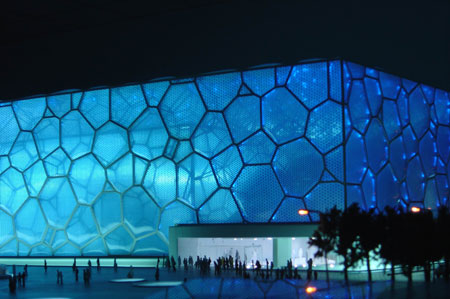Denis Weaire#
In 1993, Danis Weaire and Robert Phelan used computer simulation to come up with a counter example to Lord Kelvin's conjecture on which surface was the most economical way to divide space into cells of equal size with the least surface area. This counter-example is now known as the Weaire–Phelan structure. In 2008, this structure was an integral part of the design of the Beijing National Aquatics Center used in the Summer Olympic Games in Beijing for swimming competitions.
The Weaire-Phelan structure consists of two different bubble shapes: an irregular dodecahedron, which has twelve irregular pentagonal faces, and a solid with two hexagonal and twelve pentagonal faces, known succinctly as a tetrakaidecahedron. The structure is completely regular, and therefore easy to construct. However, it also mimics the irregular appearance of a real foam rather well and this is why it was chosen as inspiration for the Beijing National Aquatics Center, nicknamed Water Cube. The outer wall is pure Weaire-Phelan. The Weaire-Phelan structure is completely regular. However, it is quite complex, so if one cuts it along some (carefully chosen) "random" plane, it looks very irregular. This is what the architect of the building did. So the interface that you see is pure Weaire-Phelan. The building is carved out of a Weaire-Phelan foam along planes that make the structure appear random (and thus more optically appealing).
The winning team of of Australian architecture firm PTW, Arup, and the China State Construction and Engineering Corporation (CSCEC) used the Weaire-Phelan geometry to create the Water Cube's exterior cladding. It is made of of 4,000 ETFE bubbles, some as large as 9.14 meters (30 feet) across, with seven different sizes for the roof and 15 for the walls. The structure allows more light penetration than traditional glass while providing a potential 30% reduction in energy costs.
With a steel framework of seemingly random polyhedrons covered in soft plastic pillows, the center, known as the Water Cube and home to the swimming and diving events at the Olympics beginning this week, “really looks like nothing else in the world,” said Tristram Carfrae, the structural engineer who designed it. “It’s a box made of bubbles.”
Here is an impressive Presentation about the Aquatic Center as pdf-File!
as pdf-File!
#
Possibly interesting links#
- Beijing National Aquatics Center

- Newspaper reports on the Aquatics Center:
- http://www.nytimes.com/2008/08/05/sports/olympics/05swim.html?_r=1&oref=slogin#

- http://archives.tcm.ie/businesspost/2008/07/20/story34499.asp

- http://www.sciencenews.org/index/generic/activity/view/id/34283/title/Math_Trek__A_building_of_bubbles

- http://www.architectureaustralia.com/aa/aaissue.php?issueid=200607&article=18&typeon=3

- http://www.nytimes.com/2008/08/05/sports/olympics/05swim.html?_r=1&oref=slogin#
- The University of Dublin, Trinity College

- Denis Weaire, F.R.S., The Irish Scientist
 by Eoin O'Neill, 1999
by Eoin O'Neill, 1999
- Nice YouTube interview with Denis Weaire

Any further pages in alphabetic order of their title as created for or by you.
#
Just click at "Create new page", then type a short title and click OK, then add information on the empty page presented to you (including maybe a picture from your harddisk or a pdf-file by using the "Upload" Button) and finally click at "Save".


